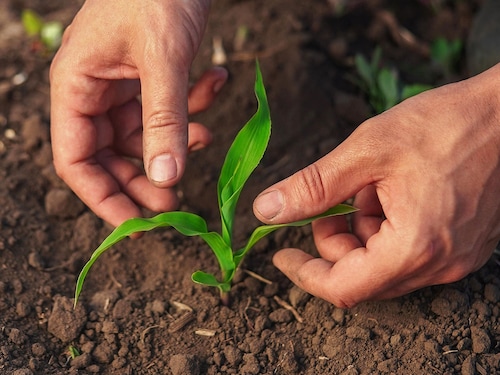Soil: A 'Climate-Positive' asset for environmental and food security in India
Soil is not just the foundation of agriculture; it is a climate-positive asset with the potential to help mitigate climate change and enhance environmental sustainability


Soil is often overlooked as a resource, but it is critical not just when it comes to food production but also in mitigating climate change. In India, where agriculture sustains over 60 percent of the population, healthy soil is essential not only for food security but also for climate resilience. However, soil degradation, exacerbated by overexploitation, chemical-intensive farming, and climate stress, significantly threatens agricultural productivity and environmental sustainability.
According to the Indian Council of Agricultural Research (ICAR), nearly 30 percent of India’s agricultural land is affected by soil degradation due to erosion, salinisation, waterlogging, and overuse of chemical fertilisers and pesticides. This leads to reduced agricultural productivity, loss of soil fertility, and increased greenhouse gas emissions. Amid these challenges, carbon credits and soil management solutions that harness soil as a carbon sink are key to turning soil into a climate-positive asset--helping to secure both environmental and food security in India.
Soil plays a critical role in combating climate change by acting as a carbon sink, meaning it captures and stores carbon dioxide (CO2) from the atmosphere. In fact, soil holds more carbon than the atmosphere and vegetation combined. When managed sustainably, soil can sequester carbon through practices like crop rotation, use of organic manure, and biochar application, among others. These methods enhance soil health while also promoting carbon sequestration, making soil an invaluable tool in the fight against climate change.
In India, the agricultural sector is a major contributor to greenhouse gas emissions and one of the most vulnerable to climate change impacts. Farmers can significantly reduce emissions, restore degraded lands, and increase agricultural productivity by adopting soil-friendly farming practices that sequester carbon. However, widespread adoption requires incentives—this is where carbon credits come into play.
Carbon credits provide a financial incentive for farmers to adopt sustainable farming practices that store carbon in the soil. By reducing emissions or sequestering carbon, farmers can generate carbon credits, which are sold in global carbon markets to buyers such as corporations, governments, and NGOs. These buyers purchase carbon credits to offset their own emissions, helping them meet sustainability targets.
In Roorkee, Uttarakhand, Mr Ravi Kiran Saini (President of the Bhu Amrit Farmer Producer Company) and 1064 other progressive farmers have taken the leap forward and embraced regenerative and organic farming--setting themselves up for trading in the global carbon market. All certified ‘organic’ farmers will soon reap the rewards of their efforts via pay-outs thanks to the sale of carbon credits on the international market.
However, while carbon credits hold great promise, their adoption in India remains limited, particularly among smallholder farmers. Key challenges include a lack of awareness about sustainable soil practices like no-till farming, agroforestry, and composting, as well as limited knowledge of their long-term benefits. Financial barriers also play a significant role, as these practices often require upfront investment in equipment or organic inputs that small-scale farmers cannot afford. Additionally, there are challenges in terms of measurement, reporting, and verification (MRV) of carbon reductions. Without clear incentives, such as subsidies or accessible carbon credit schemes, these methods appear less appealing. Moreover, resistance to changing traditional farming practices and lacking infrastructure for monitoring soil carbon levels further complicate the transition.
To scale up carbon credit programmes and ensure that their benefits reach farmers, NGOs have a vital role in bridging the gap between farmers and carbon markets.
1.Raising Awareness and Educating Farmers: Many farmers, especially smallholders, are unaware of how carbon credits work and how they can benefit. NGOs can play a pivotal role in educating farmers about the carbon market, the benefits of soil carbon sequestration, and how to participate. This can be achieved through workshops, local training programs, and partnerships with agricultural extension services.
2.Building Capacity for MRV: Carbon credit programs require precise monitoring and verification of carbon sequestered through soil practices. This process can be complex and costly for farmers to manage on their own. NGOs can help by providing tools, resources, and training to assist farmers in accurately measuring soil carbon and maintaining the necessary records for carbon certification.
3.Creating Financial Models and Cooperatives: Smallholders often face financial barriers when adopting sustainable practices. NGOs can help create cooperative models, where groups of farmers can pool resources to implement soil carbon sequestration practices and share the proceeds from carbon credits. Additionally, partnerships with microfinance institutions can provide low-interest loans to support the upfront costs of transitioning to sustainable agriculture.
4.Advocating for Policy Support: NGOs can lobby for stronger policies that support carbon markets and incentivise soil carbon sequestration. This includes advocating for subsidies, tax incentives, or government-funded training programs that make it easier for farmers to access carbon markets.
Soil is not just the foundation of agriculture it is a climate-positive asset with the potential to help mitigate climate change and enhance environmental sustainability. In India, where agriculture is under pressure from both environmental degradation and the effects of climate change, soil carbon sequestration offers a powerful tool for both climate mitigation and food security. Carbon credit programs can provide the financial incentives needed to motivate farmers to adopt sustainable soil management practices. However, significant barriers remain--particularly around awareness, access to markets, and the costs of monitoring and verification.
NGOs have a crucial role in bridging these gaps by educating farmers, providing training, creating financial models, and advocating for policy support. By helping farmers to better measure, monitor, and manage their soil, India can unlock the full potential of soil as a climate-positive asset, ensuring food security and climate resilience for generations to come.
The writer is CEO of Ambuja Foundation.
First Published: Dec 05, 2024, 13:33
Subscribe Now